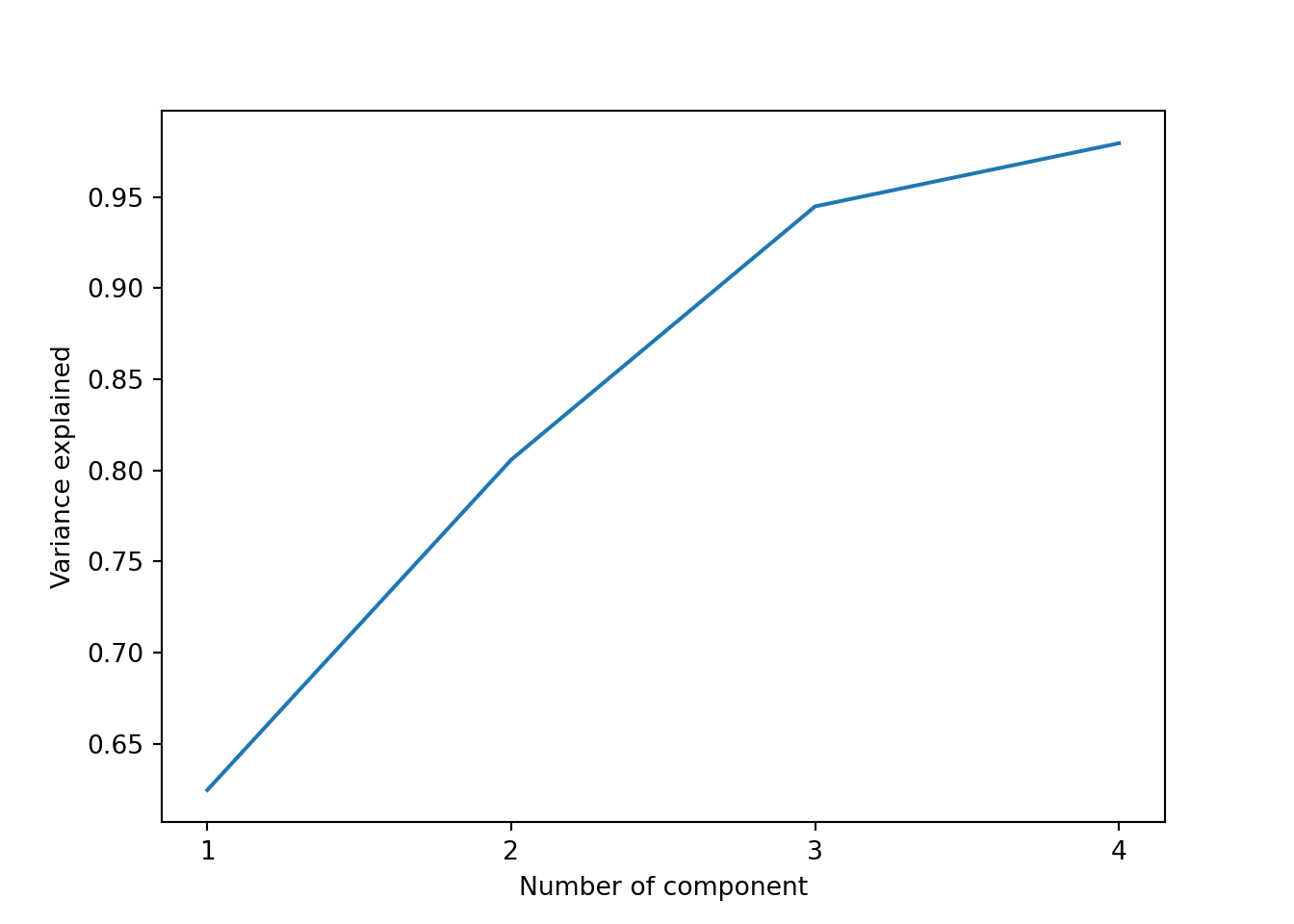FOREST FIRES IN BRAZIL
See https://www.kaggle.com/gustavomodelli/forest-fires-in-brazil for a full description of the dataset.
Import packages
import pandas as pd #Handle datasets
import seaborn as sns #Plots
import matplotlib.pyplot as plt #Plots
import matplotlib
#Set some graphical parameters
rc={'axes.labelsize': 25, 'figure.figsize': (20,10),
'axes.titlesize': 25, 'xtick.labelsize': 18, 'ytick.labelsize': 18}
sns.set(rc=rc)
#Path data
path = 'C:/Users/Andreella/Desktop/Doc/GitHub/angeella.github.io/Data'
df = pd.read_csv(path + '/amazon.csv',encoding="ISO-8859-1")First \(3\) observations:
## year state month number date
## 0 1998 Acre Janeiro 0.0 1998-01-01
## 1 1999 Acre Janeiro 0.0 1999-01-01
## 2 2000 Acre Janeiro 0.0 2000-01-01Some information about the variables:
## <class 'pandas.core.frame.DataFrame'>
## RangeIndex: 6454 entries, 0 to 6453
## Data columns (total 5 columns):
## # Column Non-Null Count Dtype
## --- ------ -------------- -----
## 0 year 6454 non-null int64
## 1 state 6454 non-null object
## 2 month 6454 non-null object
## 3 number 6454 non-null float64
## 4 date 6454 non-null object
## dtypes: float64(1), int64(1), object(3)
## memory usage: 252.2+ KBWe are interested about the number of forest fires in Brazil
## count 6454.000000
## mean 108.293163
## std 190.812242
## min 0.000000
## 25% 3.000000
## 50% 24.000000
## 75% 113.000000
## max 998.000000
## Name: number, dtype: float64To have an simple plot, we take a subset of the dataset:
We do a boxplot about the number of fire by groups, i.e., the states and the years.

We do a timeseries plot with error bands:
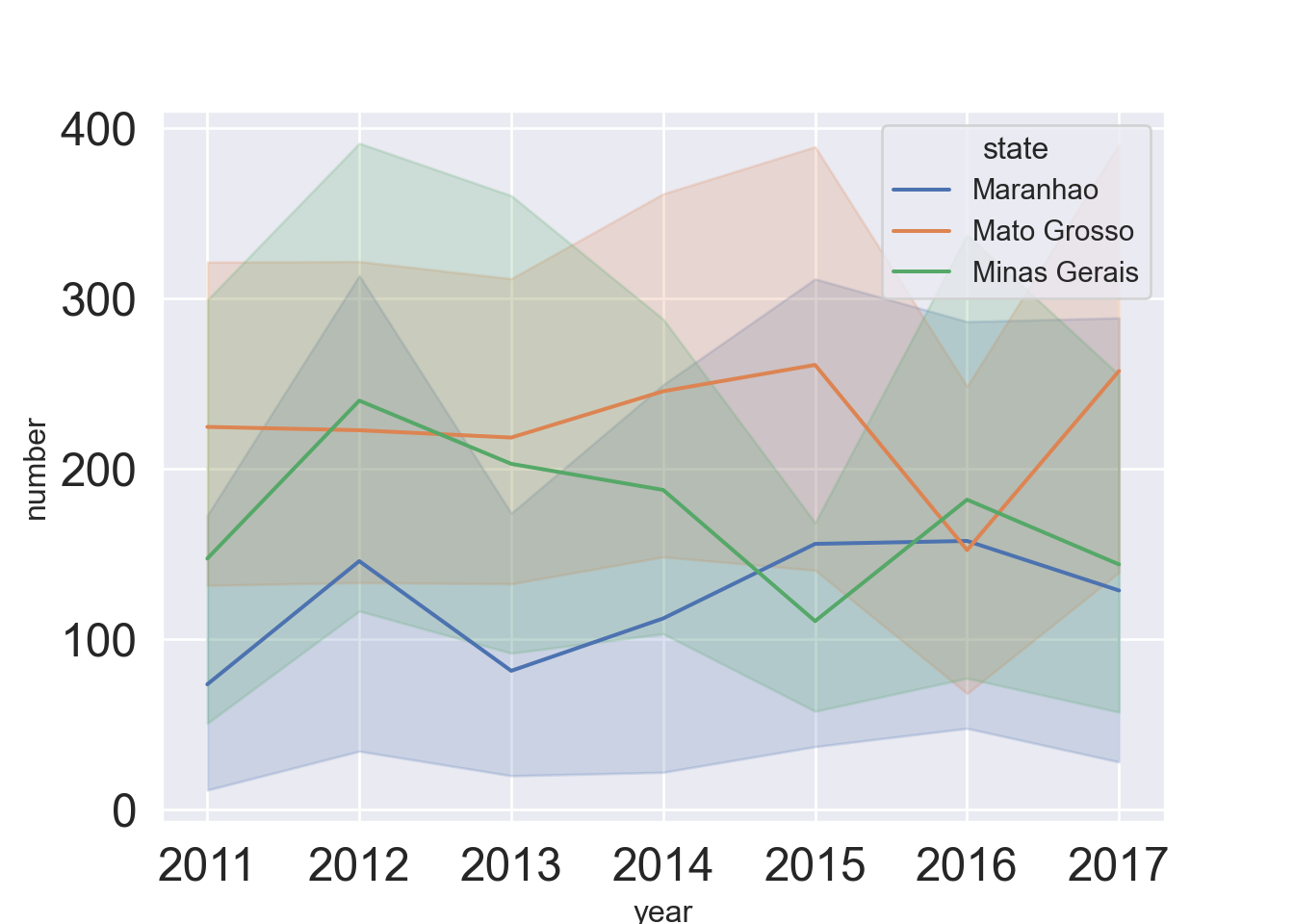
also we do a grouped violinplots:
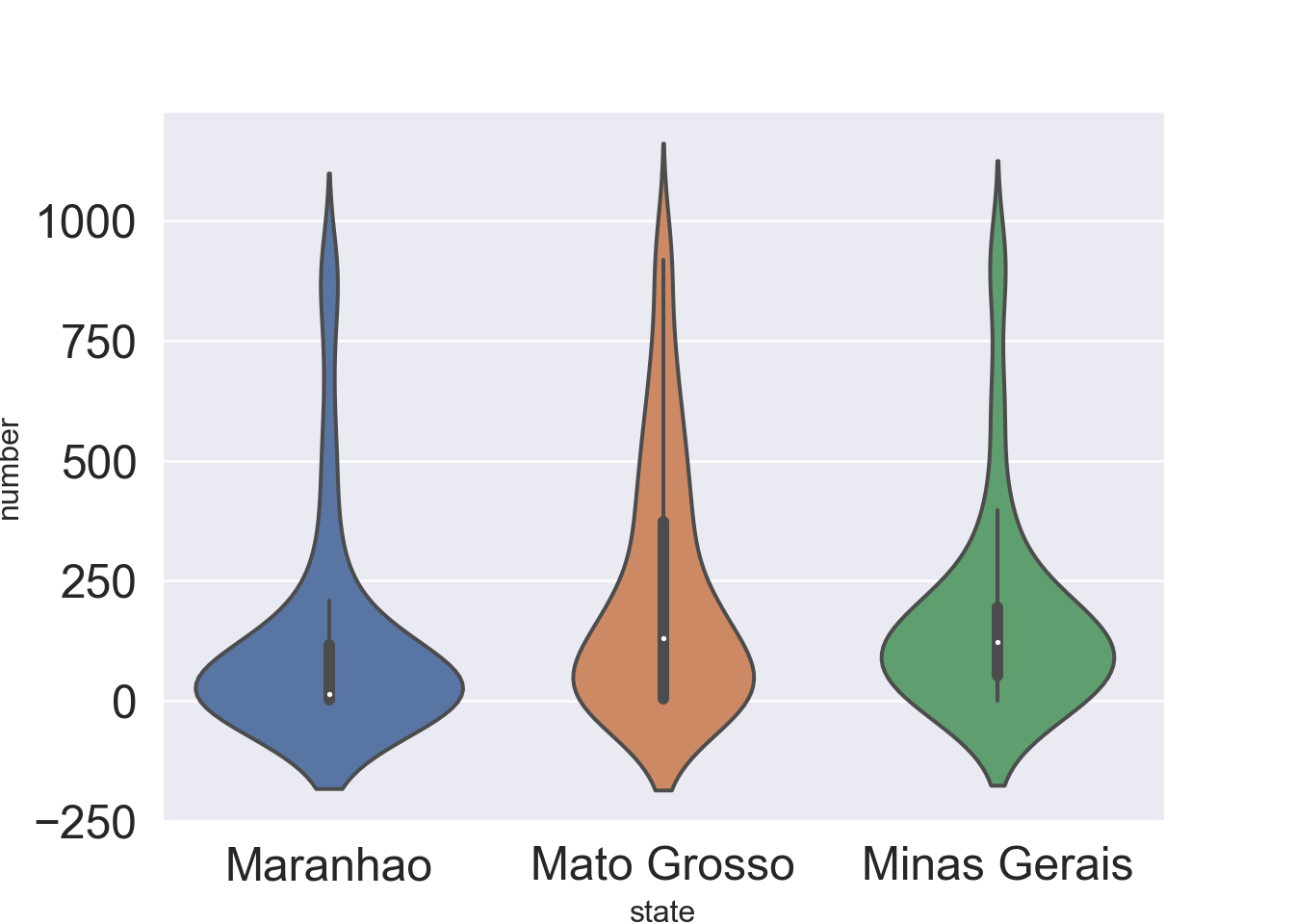
For other plots, please refers to https://seaborn.pydata.org/examples/index.html.
ECONOMIC FREEDOM INDEX
See https://www.kaggle.com/lewisduncan93/the-economic-freedom-index for a full description of the dataset.
Load and preprocess data
dt = pd.read_csv(path + '/economic_freedom_index2019_data.csv',encoding="ISO-8859-1")
dt.columns = dt.columns.str.replace(' ', '')
dt.columns = dt.columns.str.replace('2019', '')
dt.columns = dt.columns.str.replace('%', '')
dt.columns = dt.columns.str.replace('(', '')## <string>:1: FutureWarning: The default value of regex will change from True to False in a future version. In addition, single character regular expressions will *not* be treated as literal strings when regex=True.## <string>:1: FutureWarning: The default value of regex will change from True to False in a future version. In addition, single character regular expressions will *not* be treated as literal strings when regex=True.Basic info
## <class 'pandas.core.frame.DataFrame'>
## Int64Index: 173 entries, 0 to 185
## Data columns (total 34 columns):
## # Column Non-Null Count Dtype
## --- ------ -------------- -----
## 0 CountryID 173 non-null int64
## 1 CountryName 173 non-null object
## 2 WEBNAME 173 non-null object
## 3 Region 173 non-null object
## 4 WorldRank 173 non-null float64
## 5 RegionRank 173 non-null float64
## 6 Score 173 non-null float64
## 7 PropertyRights 173 non-null float64
## 8 JudicalEffectiveness 173 non-null float64
## 9 GovernmentIntegrity 173 non-null float64
## 10 TaxBurden 173 non-null float64
## 11 Gov'tSpending 173 non-null float64
## 12 FiscalHealth 173 non-null float64
## 13 BusinessFreedom 173 non-null float64
## 14 LaborFreedom 173 non-null float64
## 15 MonetaryFreedom 173 non-null float64
## 16 TradeFreedom 173 non-null float64
## 17 InvestmentFreedom 173 non-null float64
## 18 FinancialFreedom 173 non-null float64
## 19 TariffRate 173 non-null float64
## 20 IncomeTaxRate 173 non-null float64
## 21 CorporateTaxRate 173 non-null float64
## 22 TaxBurdenofGDP 173 non-null float64
## 23 Gov'tExpenditureofGDP 173 non-null float64
## 24 Country 173 non-null object
## 25 PopulationMillions 173 non-null object
## 26 GDPBillions,PPP 173 non-null object
## 27 GDPGrowthRate 173 non-null float64
## 28 5YearGDPGrowthRate 173 non-null float64
## 29 GDPperCapitaPPP 173 non-null object
## 30 Unemployment 173 non-null object
## 31 Inflation 173 non-null float64
## 32 FDIInflowMillions 173 non-null object
## 33 PublicDebtofGDP 173 non-null float64
## dtypes: float64(24), int64(1), object(9)
## memory usage: 47.3+ KBSome plots
Boxplot by group, i.e. region:
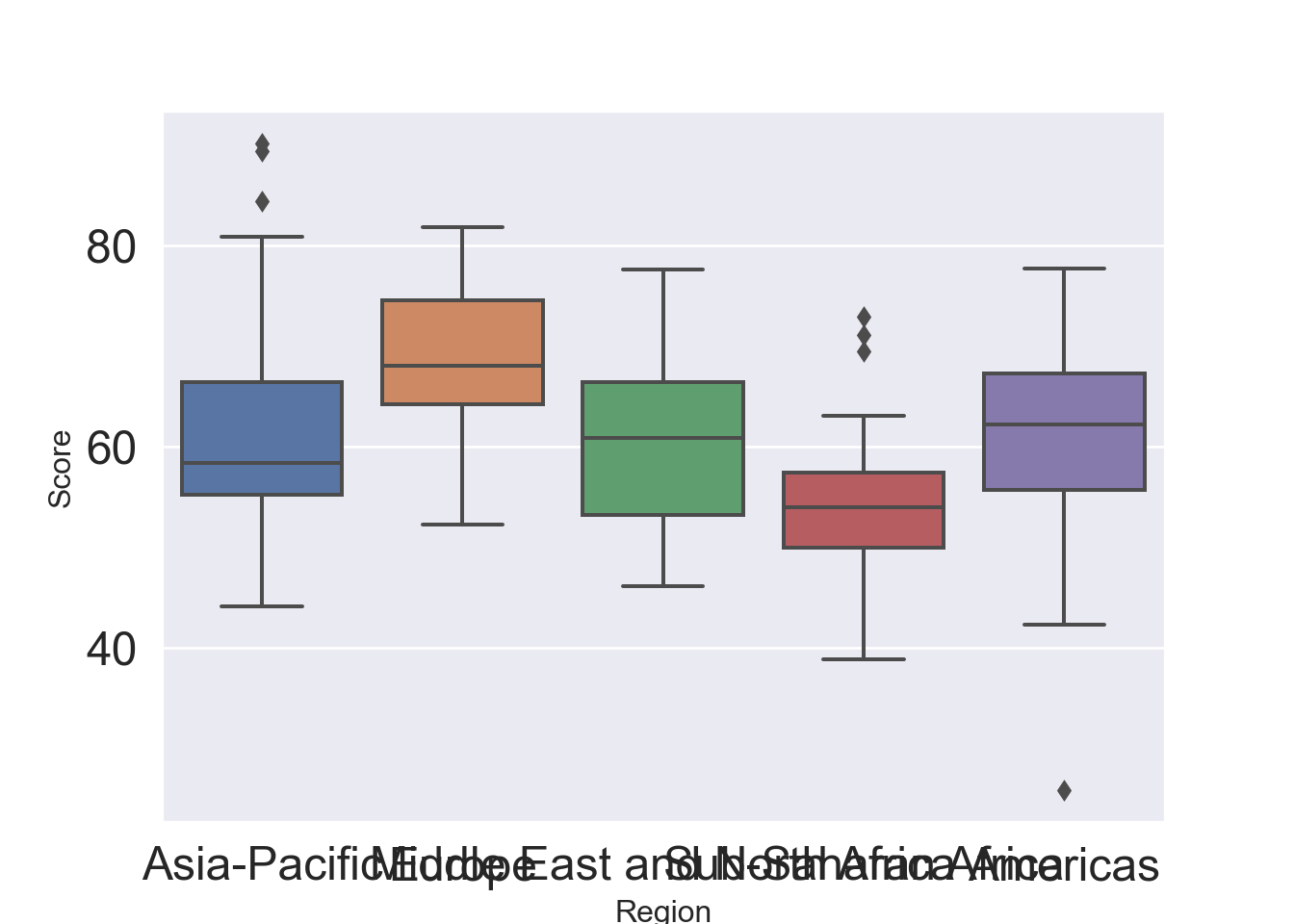
First scatter plot:
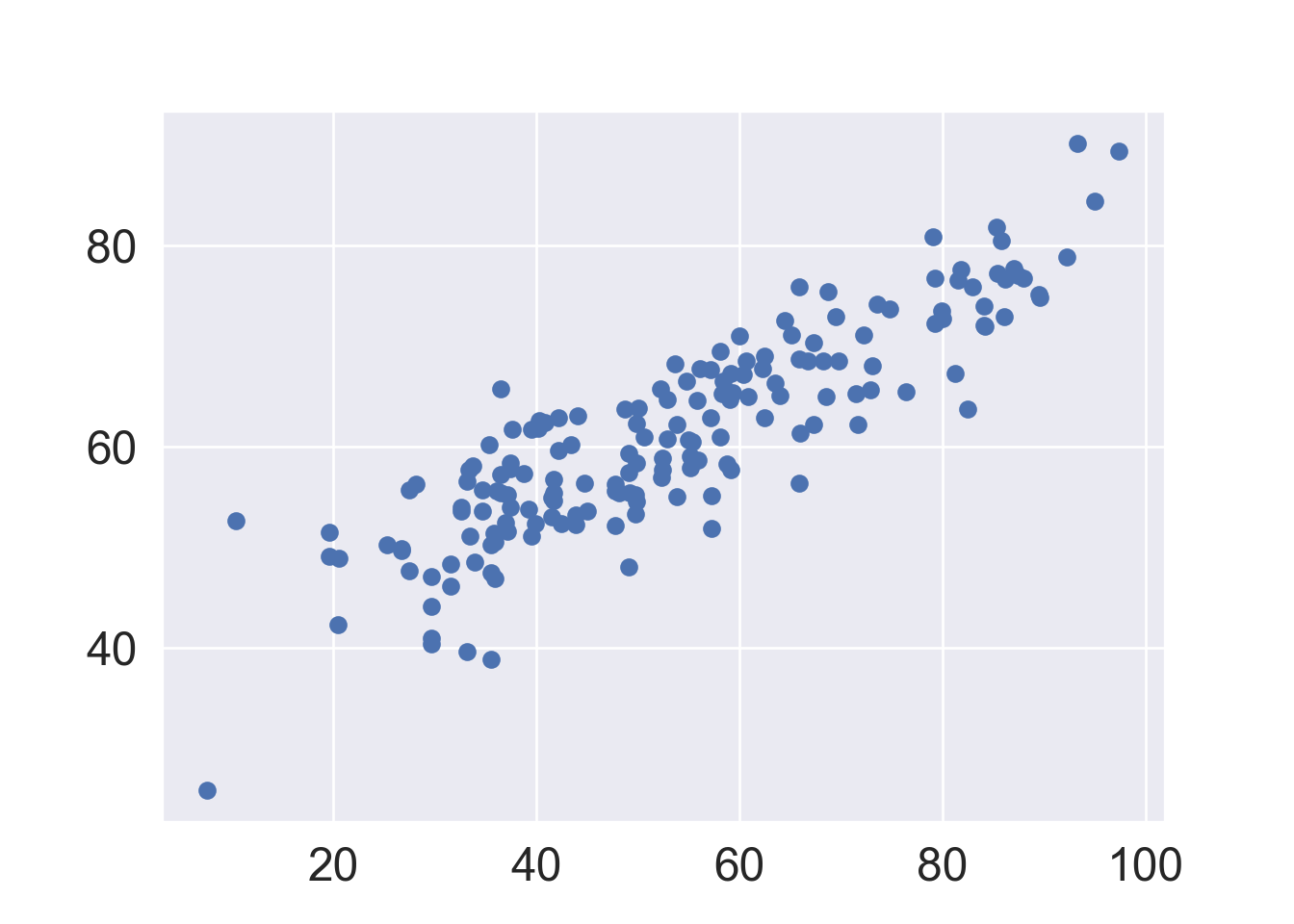
We can put directly the linear regression fitting:


Density plot of the score variable:
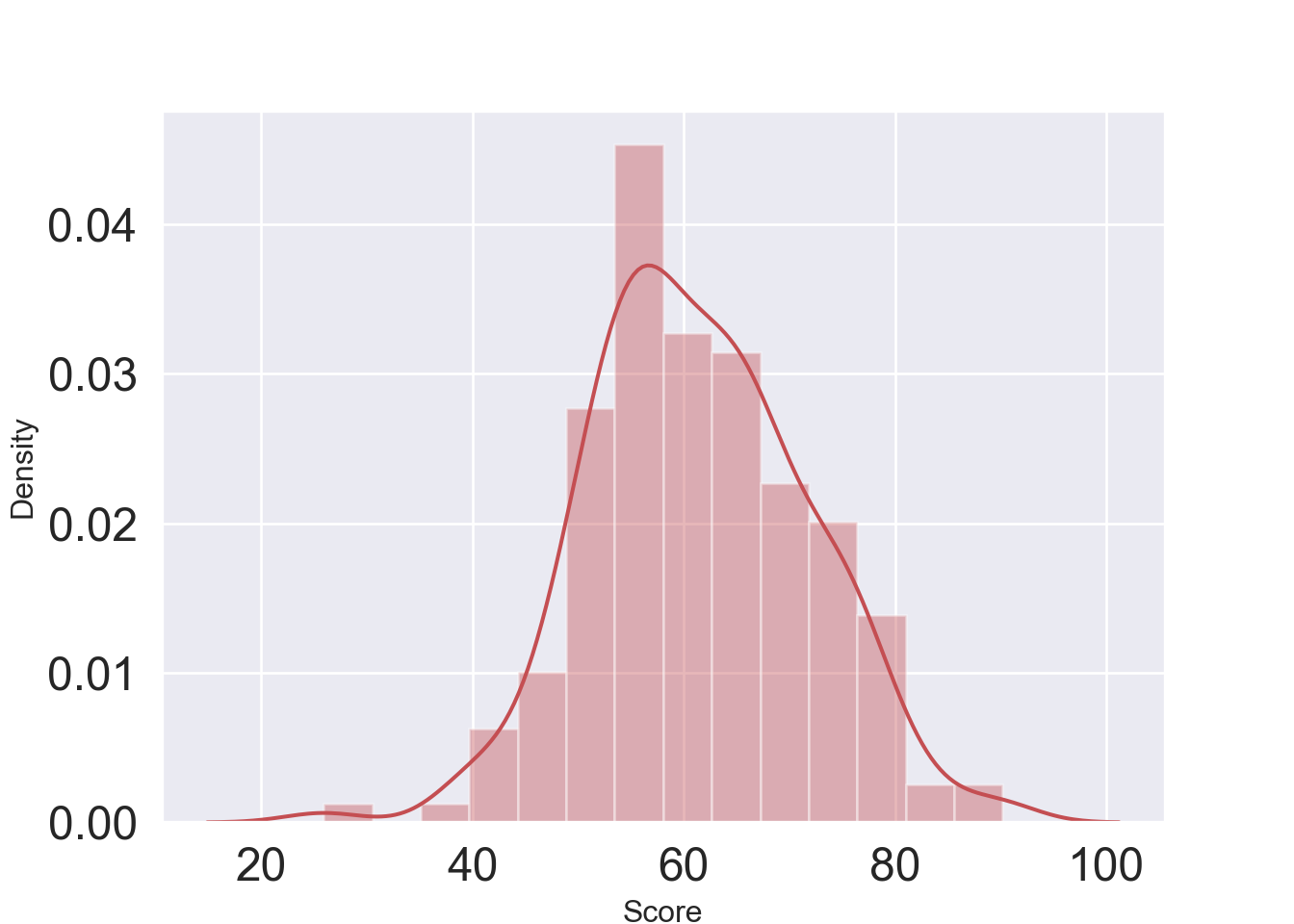
Pair plot considering some variables, i.e. Property Rights, Labor Freedom, Government Integrity, Judical Effectiveness, Fiscal Health, Region and Score:
dt1 = dt[['PropertyRights', 'LaborFreedom', 'GovernmentIntegrity', 'JudicalEffectiveness','FiscalHealth', "Score", 'Region']]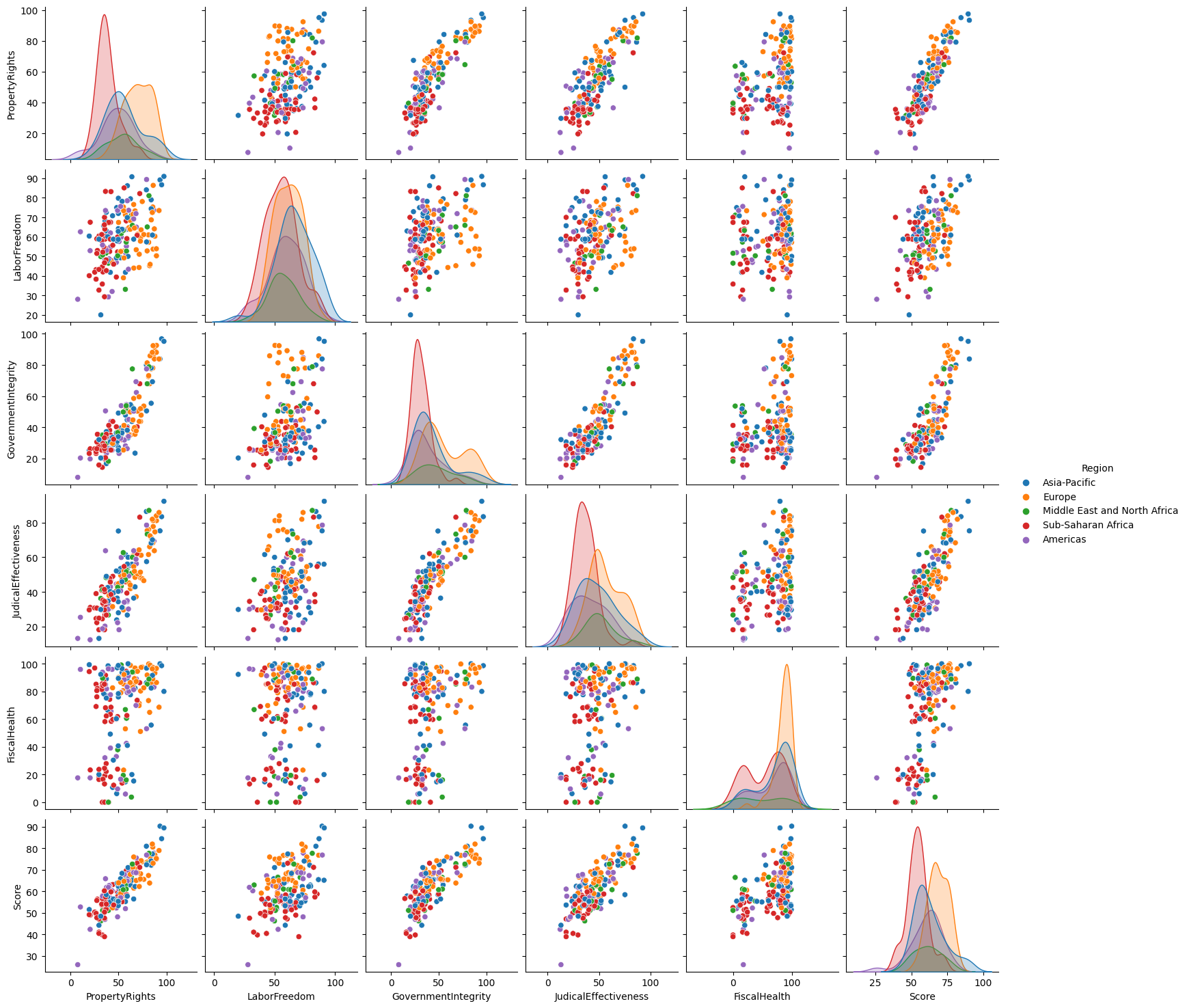
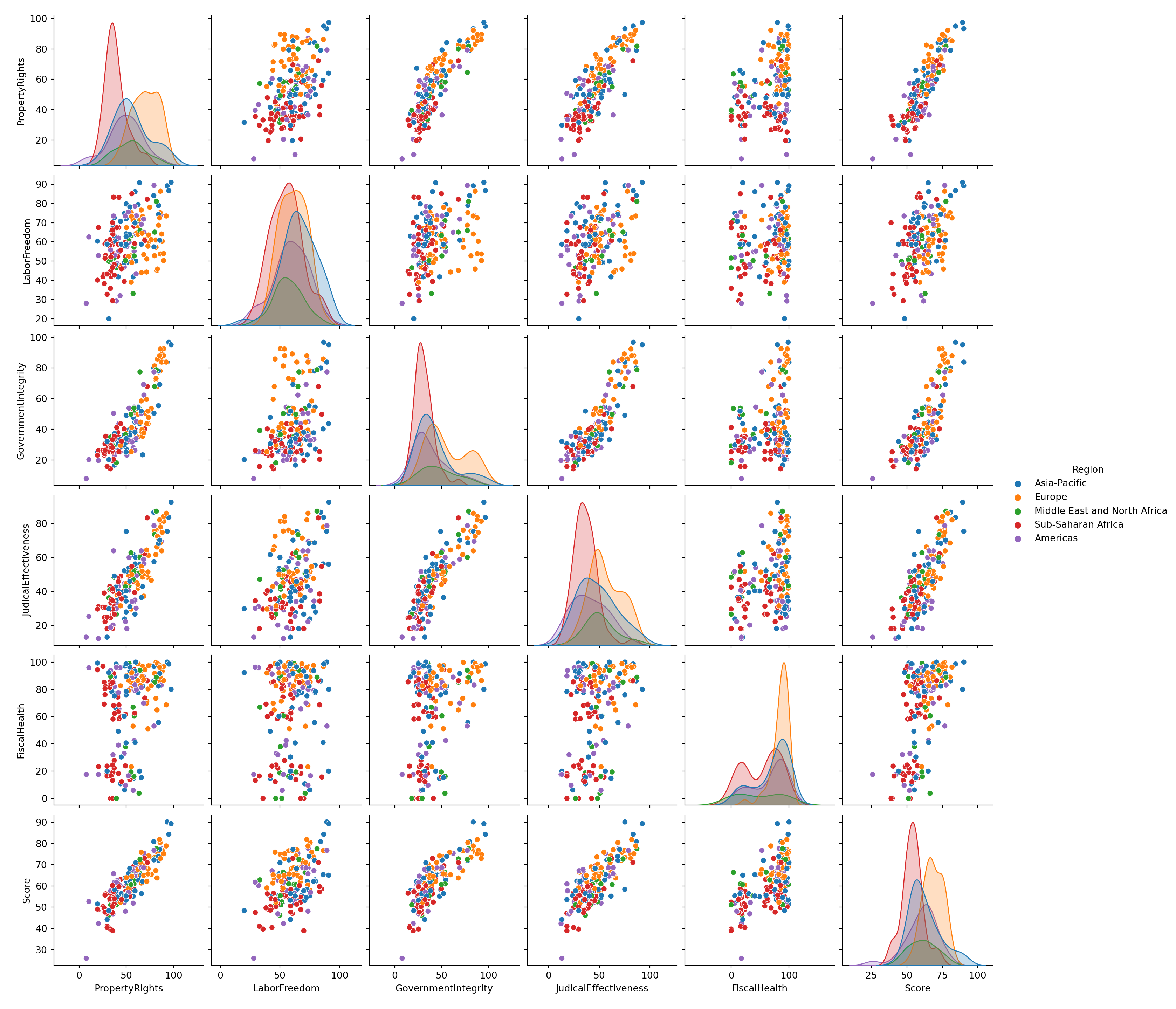
Linear regression
Import packages
import statsmodels.api as sm
import statsmodels.formula.api as smf
from sklearn.metrics import mean_squared_error
import sklearnCorrelation matrix
corr = dt[['PropertyRights', 'LaborFreedom', 'GovernmentIntegrity', 'JudicalEffectiveness','FiscalHealth', "Score"]].corr()
corr## PropertyRights LaborFreedom ... FiscalHealth Score
## PropertyRights 1.000000 0.432746 ... 0.329969 0.876601
## LaborFreedom 0.432746 1.000000 ... 0.104431 0.512976
## GovernmentIntegrity 0.866998 0.413794 ... 0.292240 0.818174
## JudicalEffectiveness 0.826805 0.421694 ... 0.287380 0.805825
## FiscalHealth 0.329969 0.104431 ... 1.000000 0.559395
## Score 0.876601 0.512976 ... 0.559395 1.000000
##
## [6 rows x 6 columns]Heatmap of the correlation matrix:
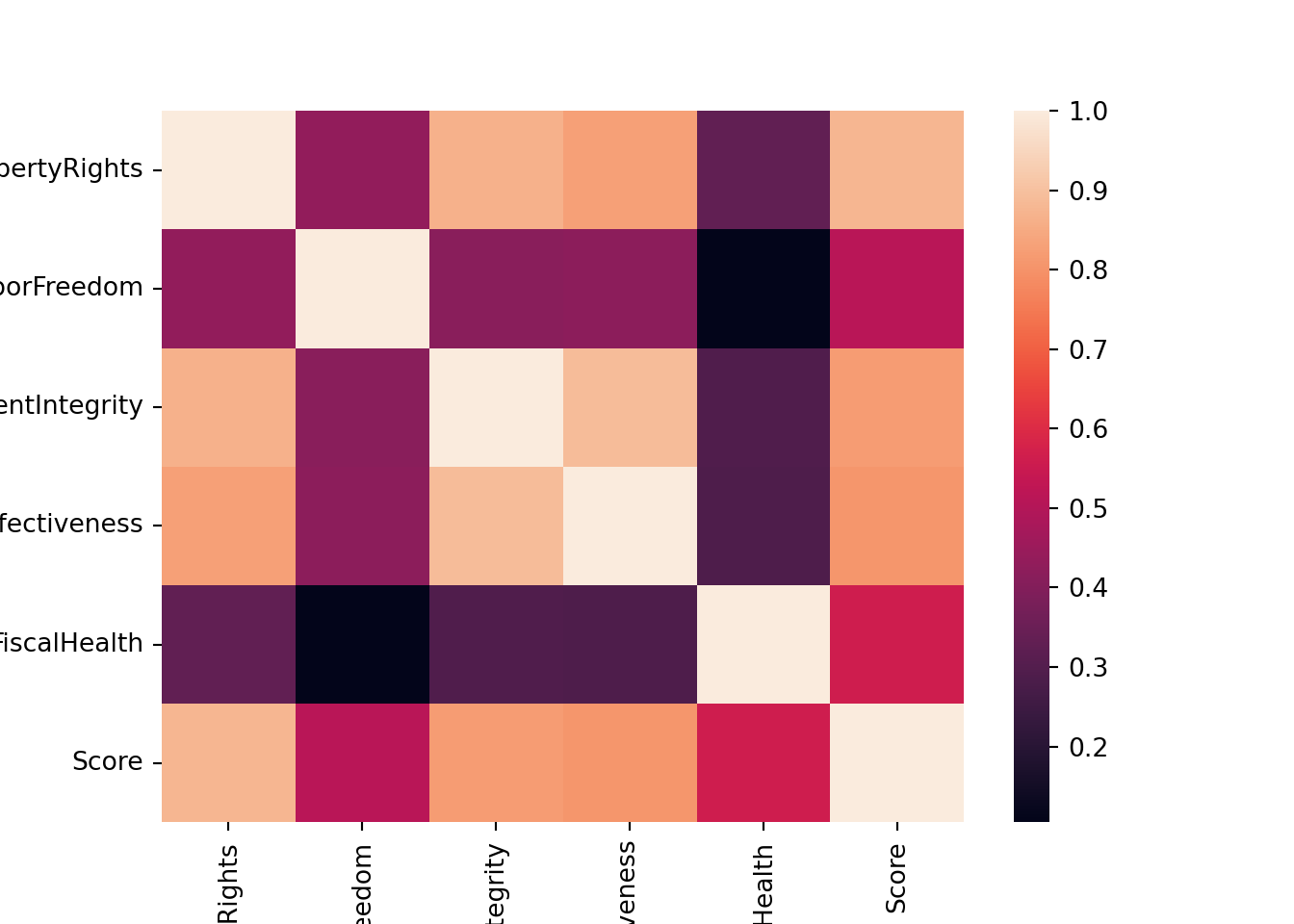
We split the dataset into training (0.8) and test set (0.2):
Linear regression having as dependent variable the Score and PropertyRights, LaborFreedom and FiscalHealth as explicative variables:
results = smf.ols('Score ~ PropertyRights + LaborFreedom + FiscalHealth', data=train).fit()
results.summary()| Dep. Variable: | Score | R-squared: | 0.869 |
|---|---|---|---|
| Model: | OLS | Adj. R-squared: | 0.866 |
| Method: | Least Squares | F-statistic: | 282.3 |
| Date: | Tue, 11 Nov 2025 | Prob (F-statistic): | 3.15e-56 |
| Time: | 11:13:31 | Log-Likelihood: | -363.21 |
| No. Observations: | 132 | AIC: | 734.4 |
| Df Residuals: | 128 | BIC: | 745.9 |
| Df Model: | 3 | ||
| Covariance Type: | nonrobust |
| coef | std err | t | P>|t| | [0.025 | 0.975] | |
|---|---|---|---|---|---|---|
| Intercept | 27.3149 | 1.636 | 16.693 | 0.000 | 24.077 | 30.553 |
| PropertyRights | 0.3776 | 0.020 | 18.741 | 0.000 | 0.338 | 0.417 |
| LaborFreedom | 0.1158 | 0.028 | 4.207 | 0.000 | 0.061 | 0.170 |
| FiscalHealth | 0.1007 | 0.012 | 8.657 | 0.000 | 0.078 | 0.124 |
| Omnibus: | 4.401 | Durbin-Watson: | 1.700 |
|---|---|---|---|
| Prob(Omnibus): | 0.111 | Jarque-Bera (JB): | 4.266 |
| Skew: | -0.440 | Prob(JB): | 0.118 |
| Kurtosis: | 2.969 | Cond. No. | 526. |
Notes:
[1] Standard Errors assume that the covariance matrix of the errors is correctly specified.
We predict the score values using the test set:

Compute the mean squared error:
## 8.981537071084368We try to use a linear mixed model, considering as random effects the Region variable.
md = smf.mixedlm("Score ~ PropertyRights + LaborFreedom + FiscalHealth", train, groups="Region")
mdf = md.fit()
mdf.summary()| Model: | MixedLM | Dependent Variable: | Score |
| No. Observations: | 132 | Method: | REML |
| No. Groups: | 5 | Scale: | 14.1628 |
| Min. group size: | 10 | Log-Likelihood: | -371.8209 |
| Max. group size: | 36 | Converged: | Yes |
| Mean group size: | 26.4 |
| Coef. | Std.Err. | z | P>|z| | [0.025 | 0.975] | |
|---|---|---|---|---|---|---|
| Intercept | 26.132 | 1.873 | 13.954 | 0.000 | 22.461 | 29.802 |
| PropertyRights | 0.391 | 0.023 | 16.752 | 0.000 | 0.345 | 0.437 |
| LaborFreedom | 0.120 | 0.027 | 4.364 | 0.000 | 0.066 | 0.174 |
| FiscalHealth | 0.106 | 0.012 | 8.773 | 0.000 | 0.083 | 0.130 |
| Region Var | 1.146 | 0.389 |
See http://www.statsmodels.org/stable/index.html for other commands about the linear (mixed) model. Also, https://www.statsmodels.org/stable/examples/notebooks/generated/mixed_lm_example.html makes a comparison between R lmer and Statsmodels MixedLM.
Principal Component Analysis
Import packages:
from sklearn.preprocessing import StandardScaler
from sklearn.decomposition import PCA
import numpy as npStandardize data:
features = ['PropertyRights', 'LaborFreedom', 'GovernmentIntegrity', 'JudicalEffectiveness','FiscalHealth']
# Separating out the features
x = dt.loc[:, features].values
# Separating out the target
y = dt.loc[:,'Score'].values
# Standardizing the features
x = StandardScaler().fit_transform(x)Perform PCA considering \(2\) principal components:
## (173, 5)## (173, 4)Plot the first \(2\) principal components:
plt.scatter(projected[:, 0], projected[:, 1],
c=y, edgecolor='none', alpha=0.5,
cmap=plt.cm.get_cmap('seismic', 10))
plt.xlabel('component 1')
plt.ylabel('component 2')
plt.colorbar()## <matplotlib.colorbar.Colorbar object at 0x00000255B6038490>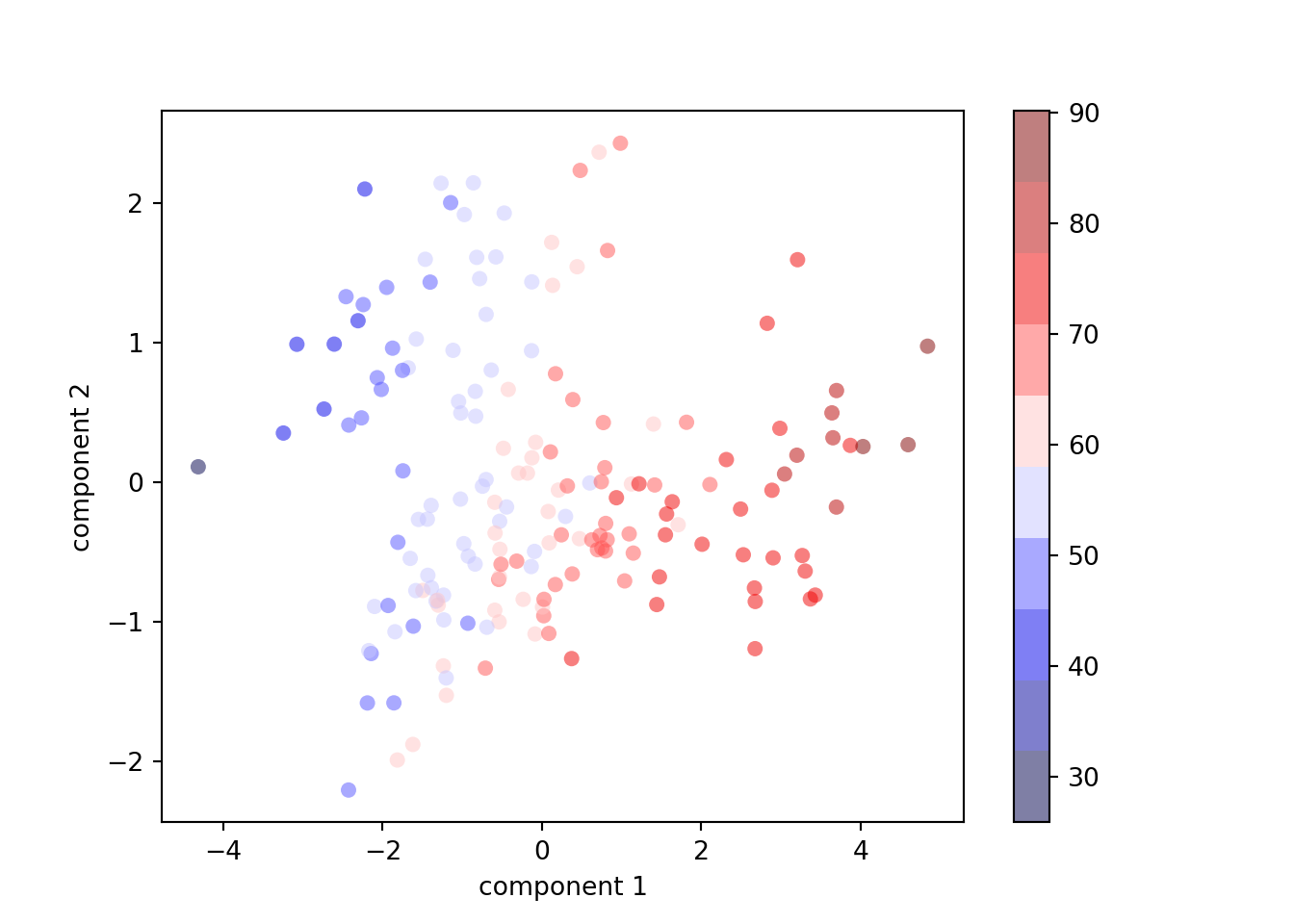
plt.plot(np.cumsum(pca.explained_variance_ratio_))
plt.xlabel("Number of component")
plt.ylabel("Variance explained")
plt.xticks(range(4), [1,2,3,4])## ([<matplotlib.axis.XTick object at 0x00000255B60C7610>, <matplotlib.axis.XTick object at 0x00000255B60C75E0>, <matplotlib.axis.XTick object at 0x00000255B60AD310>, <matplotlib.axis.XTick object at 0x00000255B61066D0>], [Text(0, 0, '1'), Text(1, 0, '2'), Text(2, 0, '3'), Text(3, 0, '4')])